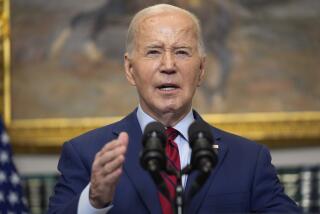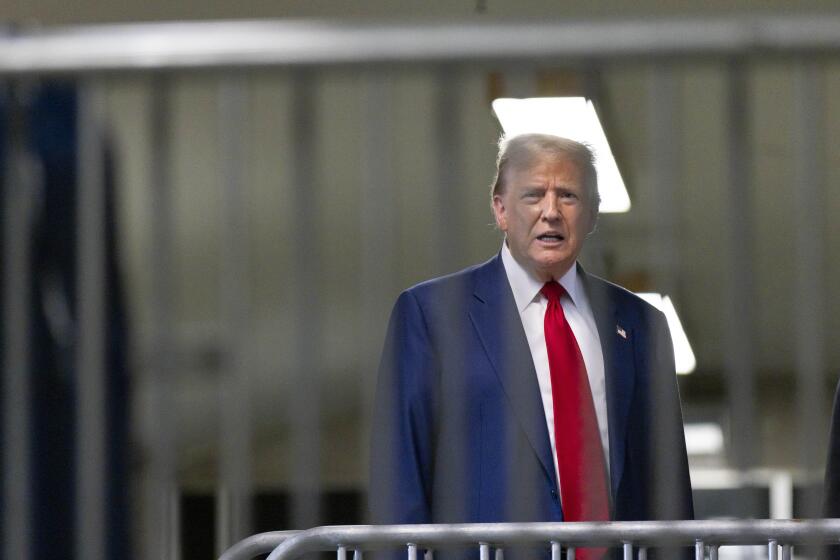Kremlin Counting on a Gusher
In a deep aquamarine fjord several miles off the coast of this chilly Arctic seaport, the biggest supertanker in the Russian oil fleet has dropped permanent anchor.
Oil plumbed deep underneath Siberia is pumped by pipeline 550 miles to a transport terminal, shipped an additional 475 miles in railroad cars to the White Sea and finally ferried on icebreakers 450 miles across the water to this colossal floating oil terminal. Oceangoing tankers sidle up to it like calves at a teat, swallowing petroleum cargoes bound for Europe and the U.S.
Only in the supercharged world of Russian oil would this Rube Goldberg way of moving crude to market not only make sense but also make money.
“All our logistical plans were tied to the government building a pipeline in the north. But the government didn’t build the pipeline. So we organized our own scheme,” said Dmitry Bogdanov, vice president in charge of export for OAO Rosneft Oil Co., the once-negligible state oil company that is hoping -- if its other schemes go right -- to soon become Russia’s largest oil producer.
Next week, the road show for the first public sale of Rosneft stock gets underway in what is expected to be Russia’s largest-ever initial public offering, aimed at raising $8 billion to $10 billion to pay off the debt Rosneft shouldered in 2004 by taking over the crown production asset of Yukos Oil Co. and effectively renationalizing much of the Russian oil industry.
Once the IPO is over, Russian President Vladimir V. Putin will have largely realized his ambition to create a massive, state-controlled energy sector able to act as a strategic lever of foreign policy. In exchange for private and foreign investment, Russia offers shareholders the relative transparency and operating efficiencies that have not historically been part of its public oil and gas sector.
Gazprom, the state-controlled gas behemoth, in January opened its doors to foreign investment while assuring a secure 51% stake for the government. Its stock price has more than quadrupled in the last year, with a market capitalization, at $227.3 billion, bigger for a while this year than Microsoft Corp.’s.
Now comes Rosneft, a company that only a few years ago was an awkward holdover of the old Soviet oil ministry, holding a scattering of production fields that hadn’t already been snatched up by the nation’s wilier oil oligarchs.
The company managed to get its hands on a few important assets in the far north and eastern Siberia, not to mention big stakes in the oil and gas boom on Sakhalin Island.
But the big turnaround came in 2004, when in the widely publicized government tax assault on Yukos, the private oil company’s main production facility at Yugansk was sold off at a fraction of its value in a questionable transaction managed by the Kremlin. Rosneft -- whose board chairman, perhaps not coincidentally, is Igor Sechin, Putin’s deputy chief of staff -- emerged holding the title.
Overnight, Yuganskneftegaz tripled Rosneft’s output to 1.5 million barrels a day and transformed it into what Rosneft says is the world’s second-biggest oil company, in terms of reserves. Net profit shot up more than fivefold in 2005, reaching nearly $4.2 billion. But that was only the beginning of the once-obscure enterprise’s transformation.
Suddenly, as if to prove that money tends to put a damper on both memory and loyalty, at least 100 Yukos executives joined Rosneft. Nearly every major investment banking firm operating in Russia has signed on to help manage the IPO, which will also debut on the London exchange.
In April, the company announced that it had hired U.S. investment banker Peter O’Brien, who had been working on the IPO for underwriter Morgan Stanley, as vice president and chief financial officer. This month the company took on its first three independent board members, from Vneshtorgbank, Barclays Capital and the Russian Academy of Sciences.
“I have been very much surprised, not just by the declarations of their plans, but just the management and their style of behavior now,” said Nelli Sharushkina, who has long followed the Russian oil industry for Energy Intelligence.
“The first change was hiring all those people from Yukos,” she said. “Yukos had its own style. Yukos was the first company in Russia that started playing according to internationally accepted standards of corporate governance. And the people who came to the company from Yukos brought those ways of operating with them.”
O’Brien said he was attracted by the company’s “great asset base” and the apparent determination of Rosneft President Sergei Bogdanchikov to build the company into a world-class oil producer.
“Rosneft over the last two years, even without Yuganskneftegaz, has been growing faster than any of our Russian peers,” O’Brien said in an interview. “You combine growth, the asset base, Bogdanchikov’s vision, and most important for me, he wants to take the company public; he wants to be a global competitor. He understands what that means in terms of transparency, in communicating with investors.”
In a triumphant meeting with potential investors at the glitzy, limousine-and-champagne-powered Russian Economic Forum in London in April, Bogdanchikov declared that Rosneft intended to surpass every other publicly traded oil company in production by 2015.
“Last year, Rosneft extracted 1.5 million barrels of oil a day. At present, this figure is already higher. We plan to approach 2 million barrels by 2010 and 3 million by 2015,” he said.
With facilities like the floating Belokamenka oil terminal near Murmansk, Rosneft is also proving adept at getting around the pipeline bottleneck that has slowed the expansion of Russian oil exports in recent years.
Former Yukos Chief Executive Mikhail Khodorkovsky, now in prison, had championed a northern pipeline to run near here, but the Russian state pipeline monopoly, Transneft, has focused most of its energies on building a pipeline on the other end of the country to supply markets in Asia.
Undaunted, Rosneft set up a complicated but workable export mechanism, which will allow it to reliably export expanded production year-round from its oil fields in Usinsk, and also from the Vankor oil field in eastern Siberia.
This year, Rosneft expects to ship 3.17 million tons of its own oil through the big stationary tanker, whose offshore location in warm jet-stream waters gives it, unlike at other Russian ports, ice-free export capability throughout the year. Exports are expected to grow to 19 million tons a year by 2015.
About 20% of the oil shipped out of Belokamenka is delivered to the U.S.
“It’s a unique export complex, completely controlled by Rosneft, and providing new export directions for the export of Russian oil,” said Bogdanov, the export vice president.
A big uncertainty with the IPO remains its timing. Although the company has been tracking a timetable leading to a possible mid-July sales debut for months, the volatility in emerging markets over the last few weeks has hit Russia particularly hard -- the Russian Trading System index fell 9.4% on June 13, raising questions about whether now is the time to try to raise $8 billion or more.
Another question is whether big state-owned energy companies from China or India will be among the first big bidders at the table. Bogdanchikov, in an interview last week with the Russian business daily Vedmosti, denied that they would be offered a preferential strategic stake.
“Our position is the following: to give no more than 1.5% to 2% into one set of hands,” Bogdanchikov said. “If one of the majors or the large companies of Southeast Asia wants to buy, they can buy during the IPO. They can buy shares, but on the same terms as everyone else.”
The biggest doubts by far are the frequent reminders that the upcoming IPO is, in no small part, the repackaging of a questionably acquired Yukos asset (minus 83% of its tax liability after the courts axed $3.9 billion from the bill that broke up Yukos) -- and one that many minority stockholders lost their shirts on as a result of the government takeover.
With shareholder lawsuits pending, London-based F&C; Asset Management in April warned investors against the IPO. “Unless Rosneft can provide us with credible assurances that it has identified, and made adequate provisions for, any liabilities stemming from the acquisition of its Yuganskneftegaz assets, we won’t be interested,” Karina Litvack, head of corporate governance and socially responsible investment at F&C;, said in a statement.
Financier and philanthropist George Soros, whose foundation is working throughout the republics of the former Soviet Union to promote democracy and transparent market principles, questioned in a letter to the Financial Times whether the IPO should be allowed to proceed at all.
“To argue that it will improve transparency ignores the fact that Rosneft is an instrument of state that will always serve the political objectives of Russia in preference to the interests of the shareholders. Is Rosneft willing to put this in the prospectus?” he wrote.
Bogdanchikov has downplayed investment risks as a result of outstanding Yukos shareholder suits, pointing in an interview last week with the Russian business newspaper Kommersant to several cases that had been decided against such claims. “The question arises of what claims can be made against us,” he said. “We say that the Yuganskneftegaz case is closed.”
Of course, there’s another way of looking at it, many analysts say. With the Kremlin sitting at the head of the boardroom table, whatever happens to the rest of business as it navigates its way through the iceberg-strewn waters of Russia, Rosneft’s path looks like clear sailing.
*
(BEGIN TEXT OF INFOBOX)
Rosneft Oil
Founded: 1993
Headquarters: Moscow
Major businesses and assets: 10 oil- and gas-producing enterprises across Russia. Owns two refineries, four main oil export terminals and 600 service stations nationwide.
2005 oil production: 74.56 million tons
Proven oil reserves as of Dec. 31, 2005: 14.88 billion barrels
2005 revenue: $23.95 billion
2005 net income: $4.16 billion
*
Source: Company reports
More to Read
Start your day right
Sign up for Essential California for news, features and recommendations from the L.A. Times and beyond in your inbox six days a week.
You may occasionally receive promotional content from the Los Angeles Times.






